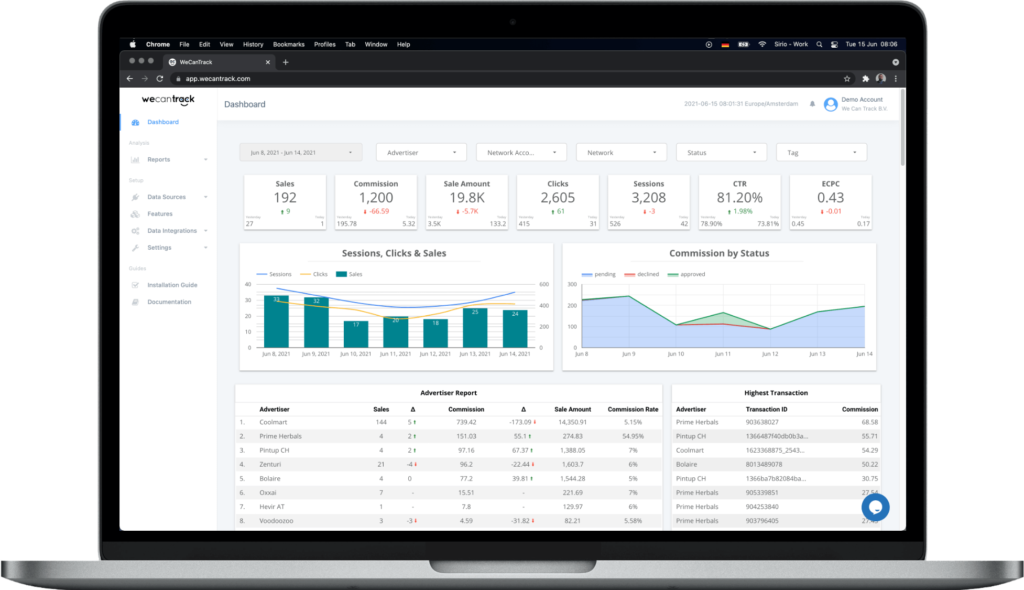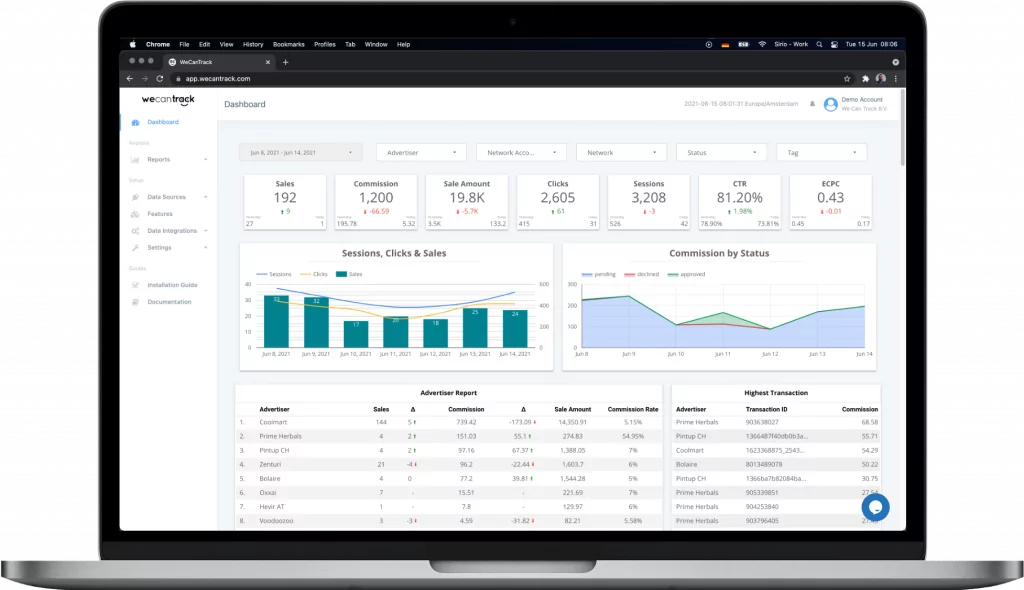Affiliate marketing is a constantly evolving branch that requires marketers to be proactive and plan to achieve success. Hence, ensuring that one is measuring the right KPIs is crucial, given that the program is environment-efficient and constantly evolving.
The date following with metrics present will market help conditions and make tracking and comprehending these metrics important. For instance, it has been projected that the flat-rate commission structure will be reduced by 15% by 2025, and the revenue-sharing model will be the most common structure. This means that to achieve good results, one needs to be versatile and performance-oriented.
This article will outline the best KPIs for improving the output and performance of your affiliate marketing campaigns in 2025.
Table of Contents
Why You Should Track Your KPIs
KPIs are the most important parameters in decision-making in affiliate marketing. KPIs help marketers assess campaigns’ results and affiliates’ performance. This is useful as it enables you to know the performance of the affiliates and the strategies that they are using.
Using this information, you can make rational decisions, including freezing the budget for low-producing affiliates, changing the content placement, or modifying the commission structure to meet the desired outcome. It’s not just numbers – it is the information that can shape the future of your affiliate program.
The Importance of KPIs in the Development of Affiliate Programs
An affiliate program must have measurable results to grow in the long run. Program growth metrics include active affiliate count, retention rates, and earnings per click (EPC) to establish whether the program is growing and running effectively.
Thus, by monitoring the program growth metrics, businesses can determine which performers to keep, which new partners to seek out based on their performance and incentives, and which weak points to eliminate.
Furthermore, KPIs highlight how to invest in technology, partnerships, and marketing to grow the program and make it profitable. Simply put, it is possible to scale an affiliate program without KPIs, but it is like driving without a map – one will most likely waste time, money, and other resources.
The Consequences Of Neglecting KPI Tracking
This is especially true in the current affiliate marketing world, characterized by competition due to neglecting KPIs. Missing important metrics can prevent a business from spending more money on low-productive campaigns or taking advantage of highly converting affiliates.
This can lead to poor budget control, hence reduced returns on investment, and also hurt affiliate retention, as partners may wish to exit due to poor guidance or subpar compensation.
Also, when operating in an environment where competitors already use analytical tools to optimize their strategies, falling behind with KPIs means you will be left behind. Therefore, it is not enough just to use KPIs; it is crucial to survive, grow in the market, and retain profitability.

22 Affiliate Marketing KPIs You Need To Track For 2025
The following affiliate marketing KPIs are crucial for affiliate marketing success. If you track these KPIs, you’re bound to succeed.
Traffic Metrics
Understanding where traffic is coming from and how users use affiliate links can help you determine where to grow your program. You can also analyze traffic patterns to tweak your strategies, reach productive sources, and improve user engagement.
Click-through rate (CTR): To track participation levels, you must look at the percentage of viewers who click on an affiliate link. Affiliate links have an average CTR of 0.05%-1%, a benchmark to measure engagement and determine the best affiliates or content.
Affiliate link click-to-sale time: Figure out how long it takes them to click an affiliate link and purchase. This KPI gives you some insights into the consumer’s decision-making process and shows us where there are delays in the conversion funnel. From a marketer’s perspective, understanding this time frame makes streamlining the buyer’s journey so effective.
Traffic source distribution: Now that you are online, identify where valuable traffic is coming from—social media, email campaigns, or organic search. Affiliate networks have 55% mobile traffic, meaning they should optimise mobile traffic strategies to meet this huge audience.
Affiliate content and link placement performance: You may want to evaluate the effectiveness of various forms of content and where your affiliate links should be on the page.
Long-form content: Over 2,000 words will get 50% more organic traffic and 700% more engagement than shorter articles and should be used as a must-have to boost performance.
Mobile vs. desktop performance: Traffic and conversion vary from device to device. Tailoring affiliate efforts to mobile users can boost conversion rate by 64%, showing that having a mobile-optimized site will improve the chances of engaging and selling to your audience.
Click-Through Rate Calculator
Conversion Metrics
Conversion KPIs help you know the number of leads and how you need to convert the leads into paying customers. These metrics are helping you determine where your dollars need to be spent.
Conversion rate: Count how many of your visitors do what you want of them. An affiliate marketing campaign can have an average conversion rate of 1 to 3%, but with highly relevant audiences, the conversion rate can be up to 5 to 10%. This, in turn, helps identify strategies that have been proven to work.
Average order value (AOV): Track total revenue per transaction to learn how consumers spend money. In affiliate sales, the average AOV is $125, thus a benchmark for evaluating program profitability and improving marketing to encourage bigger purchases.
Earnings per click (EPC): Calculate income per click on affiliate links to see which ones are profitable for you and which ones you can improve on.
Revenue per visitor (RPV): Calculate the average revenue generated for each visitor that comes from an affiliate. This traffic quality metric tells you how good an affiliate’s traffic is.
Cost per acquisition (CPA): Find out how much you need to spend on getting new customers through affiliates. A low CPA makes a business profitable while expanding its customer base.
Cost per lead (CPL): Analyze how much you spend acquiring new potential customers and then check the quality of the leads. A high CPL may suggest that you need more precise targeting or better affiliate partnerships.
Affiliate program activation rate: the number of affiliate marketers actively promoting your program once they join. With a high activation rate, a company’s affiliate engagement and onboarding strategies are said to effectively onboard new users.
Conversion Rate Calculator
Financial Metrics
Evaluating your affiliate program’s financial performance is a key part of affiliate program revenue metrics. Affiliate marketing is expected to become a $12 billion industry by 2025, thus emphasizing the need to harness these same metrics for the pipeline.
Return on ad spend (ROAS): Track the revenue you get for every dollar spent on affiliate advertising campaigns. ROAS helps identify the best and worst performing strategies to help them allocate budgets efficiently.
Return on investment (ROI): Examine the profitability of your entire affiliate marketing efforts. 85% of companies use affiliate marketing to achieve better ROI with less upfront investment. The most important part is to ensure that you can return a positive ROI, indicating that the program will surely be successful and scalable.
Profit margins: Program efficiency can be understood by calculating the percentage of revenue remaining after costs are deducted, and areas for improvement can be identified.
Affiliate retention rate: Monitor closely what percentage of affiliates will still promote your program at some point. High retention rates indicate strong relationships and program satisfaction.
Affiliate fraud rate: You can track and learn about fraudulent activities to protect your program’s integrity. Protection against fraud is vital to minimize its impact on your performance and trust.
ROI Calculator
Customer Metrics
Customer KPIs ensure your affiliate program attracts and keeps high-value customers who support your business’s goals.
Customer lifetime value (CLV): Find out how much the expected total revenue from them across their lifetime. Understanding CLV ensures you can evaluate the long-term value of affiliate-driven customers.
New vs. returning customer conversion rates: Find out how your CMS converts first-time visitors versus return customers. This metric represents the result of affiliates’ customer loyalty and effectiveness to drive repeat purchases.
New customers acquired: Track the number of first-time customers your affiliate efforts have brought in. This shows how effective your program is in growing your customer base.
Customer Lifetime Value Calculator
Program Growth Metrics
Program growth metrics tell you about scalability and long-term success. Affiliate marketing can produce between 5 and 25 per cent of sales for top companies, indicating growth potential.
Active affiliate count: When checking out the program, consider tracking how many affiliates are actively using the program and how that number is rising. The program’s appeal and market relevance result in growth in this area.
Retention rate of affiliates: Create sustainable partnerships with high-performing affiliates. Keeping these guys means steady program performance.
Average commission rate: Track the average or fixed amount paid to affiliates. In five years, 15% of websites will use dubious ways to earn affiliate commissions, and transparency and fairness will be essential to building trust.
Affiliate program growth: Count the number of new affiliate joiners each month. Regular monitoring is used to understand retention, assess recruitment efforts, and change strategies for ongoing expansion.

E-commerce SaaS affiliate programs offer affiliates the advantage of promoting subscription-based services, ensuring recurring commissions for long-term profitability.
Trends Influencing Affiliate Marketing KPIs In 2025
The following trends can influence affiliate marketing KPIs and must be remembered for the following year.
There is a shift to revenue-sharing commission models. Such models have emerged as dominant commission structures in the current scenario, offering a better alignment between the affiliate and the business objectives.
There is also an increased reliance on performance-based partnerships. In the traditional model, affiliates are compensated on results.
These days, advanced tools help us measure more specifically and better. wecantrack is an invaluable tool for monitoring and optimizing your affiliate program.
It has the following features that can help track your KPIs:
Advertiser Performance: You can view the details of each advertiser’s performance, including conversions and commissions, and even compare them over different time intervals.
Network Performance: Get a comprehensive overview of your affiliate networks’ performance with an easy-to-read network report.
Content Performance: View the clicks, conversions, and commissions that your landing pages and click pages receive and use the real data to improve your content.
Traffic Source Performance: By using session attribution and implementing a multichannel approach, you can understand the effectiveness of your traffic sources and avoid overreliance on a single channel.
Campaign Performance: Get insights into your ad campaigns so you can manage your budget and increase return on investment effectively without guessing.
Transaction Report: You will be able to get a detailed breakdown of the transaction, which includes sub-ID parameters, status, and product details for certain partners only.
If you’d like to try it, you can use our dummy affiliate dashboard.

What You Need To Do To Meet Your KPIs
The adoption of real-time tracking is projected to increase by 40% by 2025, with 72% of marketers planning to rely on real-time data for immediate campaign adjustments.
- Ensure you use advanced tools to track and understand customers’ behavior to get the right data.
- Set clear benchmarks: Defining the right points of reference for each KPI to enable the evaluation of the progress accordingly.
- Regularly review strategies: To ensure competitiveness, the affiliate strategies must be readjusted based on performance data.
Looking Forward
Affiliate marketing is a very active branch that requires the efforts of many people and cannot be static. Keep up with the critical current trends, for instance, right the KPIs revenue in sharing order models.
Marketers should focus on metrics such as traffic, conversions, revenue, and customer insight to develop effective and efficient strategies that produce tangible outcomes and sustainable returns.
By 2025, the traditional commission models are expected to be down by 15%, and performance-based partnerships and advanced analytics will become the new normal. Services such as wecantrack assist in managing and evaluating KPIs, making it easier for marketers to organize data, get real-time information, and know where to make changes.




